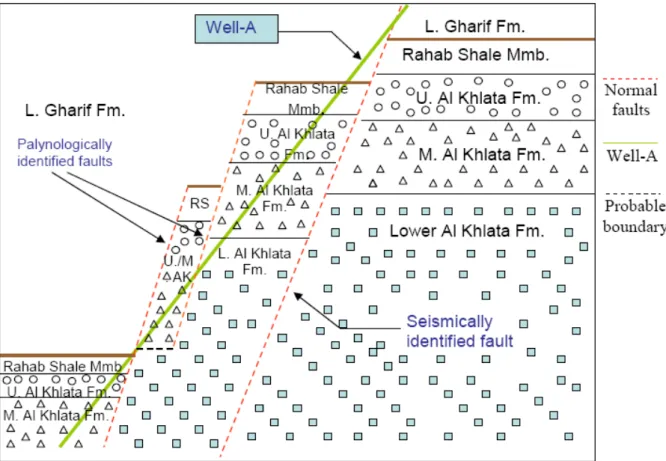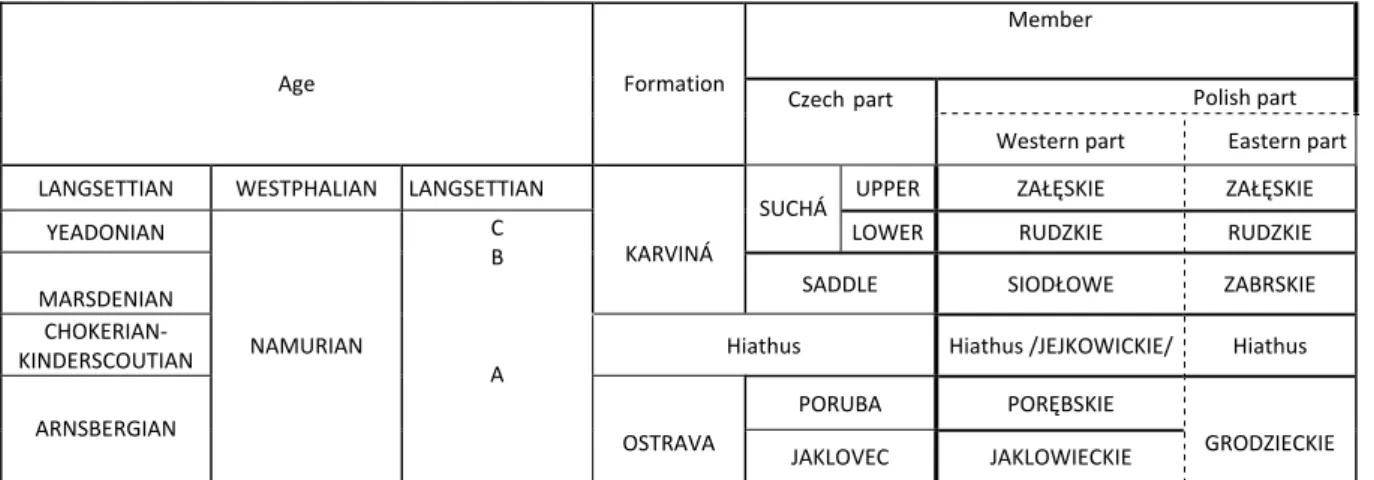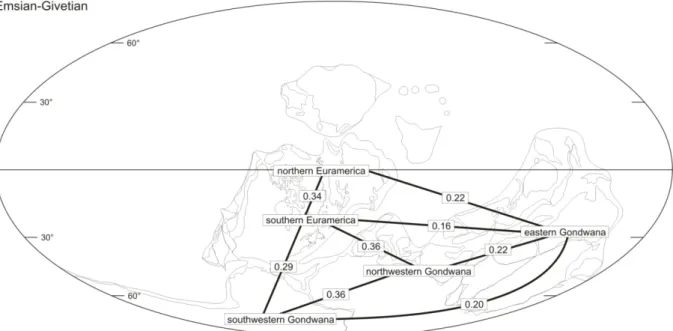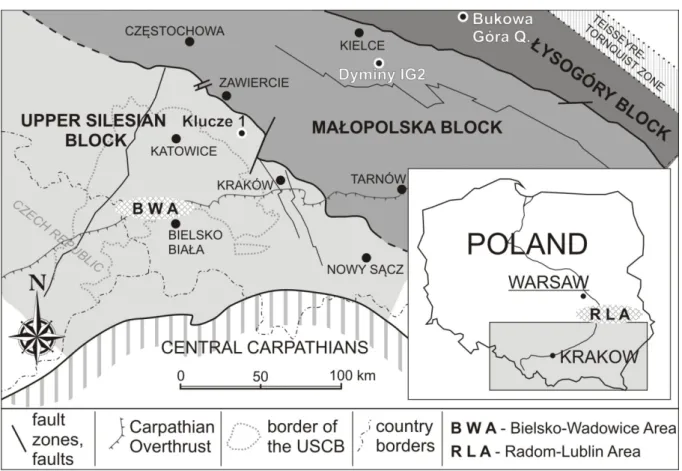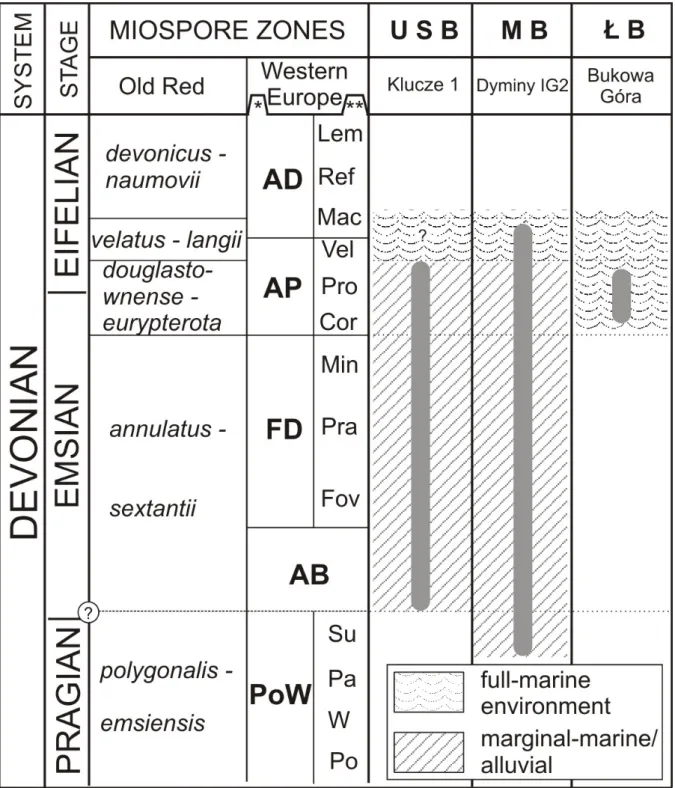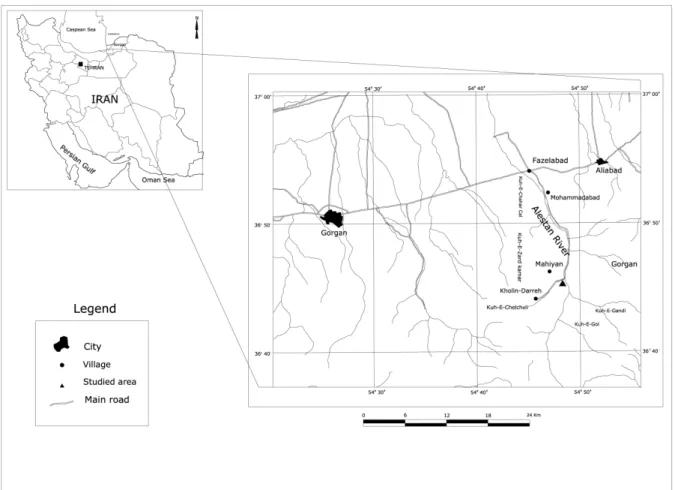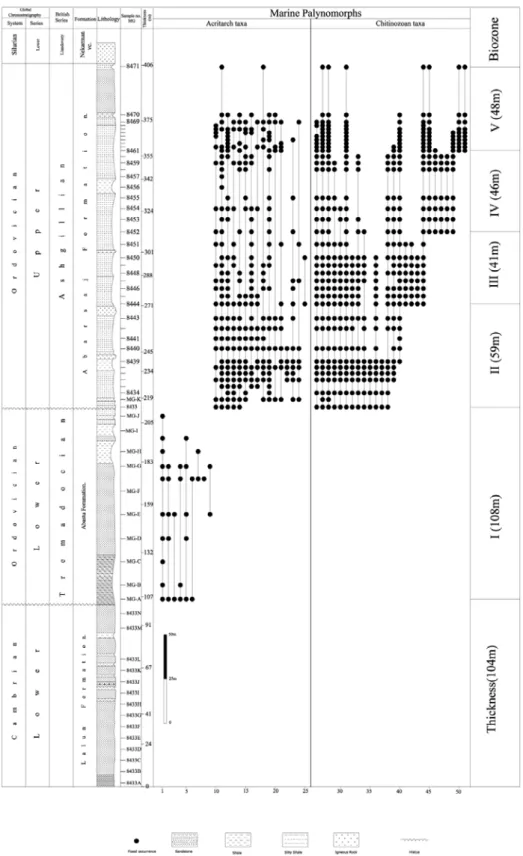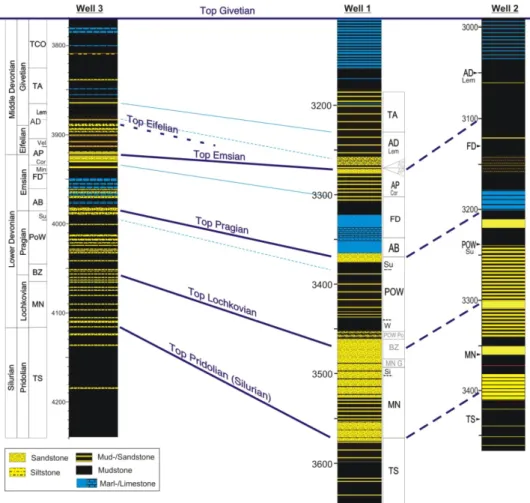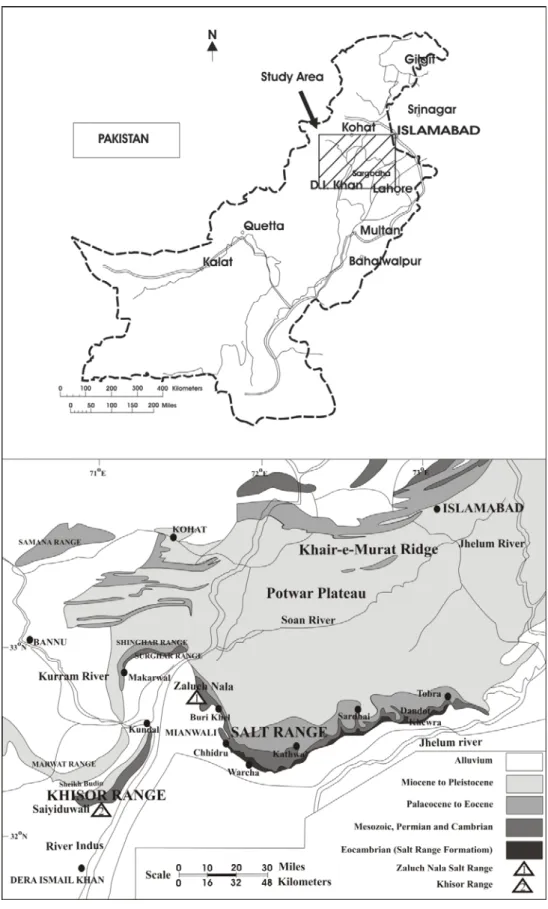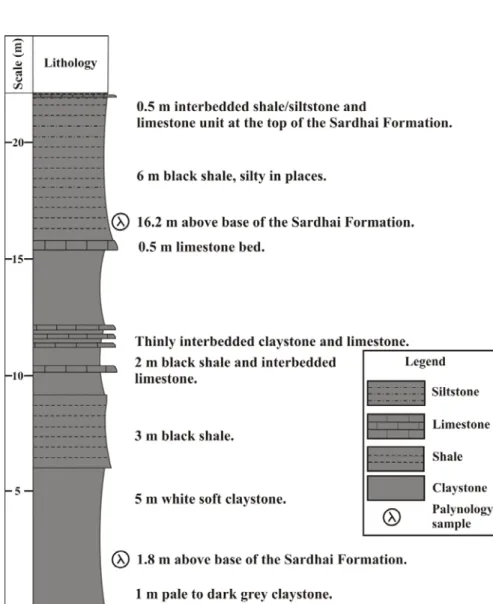TECHNICAL FILE
Graphic Design: Filipe Barreira (LNEG) Edition: LNEG
Date: September 2009 Number of copies: 50
ORGANIZING INSTITUTIONS UALG – Universidade do Algarve LNEG - LGM (Geological Survey)
SPONSORS
FCT - Fundação para a Ciência e a Tecnologia OLYMPUS - Portugal
WELCOME to CIMP Faro’09
This meeting builds on the last CIMP meeting held in 2007 in Lisbon and the suggestion of organizing a Second Joint Meeting of Spore/Pollen and Acritarch Subcommissions in Portugal was warmly accepted by us. For this year reunion theme we chose the Euramerica - Gondwana collision and the utility of palynomorphs in its reconstruction.
The meeting is co-organized by Centro de Investigação Marinha e Ambiental (CIMA) from the UALG (University of Algarve) and LNEG - LGM (Laboratório Nacional de Energia e Geologia - Geological Survey). The venue of the meeting is the University of Algarve, Campus de Gambelas, in Faro, from the 21st to the 24th of September 2009. Although, theme of the reunion is the Euramerica - Gondwana reconstruction, it is open to all researches interested in any aspect of Palaeozoic palynology. The program includes a two-day scientific and technical sessions followed by a two-day field trip to the west part of the Algarve, between Aljezur and Lagos.
In 2009 the University of Algarve commemorates its 30th anniversary; therefore it is an honour to host CIMP Faro’09 and all its delegates in this special occasion. All facilities were kindly provided by the UALG, CIMA and LNEG. Financial support for the publication of this book of abstracts was provided by Portuguese government agency Fundação para a Ciência e a Tecnologia (FCT).
The research carried out by J. Tomás Oliveira, Zélia Pereira and Paulo Fernandes, is supported by FCT research projects PYBE (POCTI/CTE-GIN/56450/2004) and Hydrocarbon Source Rock Potential of the Algarve Basin - Southern Portugal (PTDC/CTE-GEX/72694/2006).
The editors thanks Geoff Clayton, Reed Wicander and Ken Higgs for encouraging the organisation of this second CIMP meeting in Portugal and to all valuable help that greatly improve CIMP Faro’09. Special thanks to all colleagues who enthusiastically accepted to help in this meeting: Filipe Barreira for the conception of the design of the meeting, Bruno Rodrigues, Nuno Vaz and Gilda Lopes for all the logistic and technical help.
Lastly, a word to all CIMP Faro’09 participants. We express our sincere thanks to all the authors for their invaluable contributions that are published in this Book of Abstracts.
Bem‐vindos ao Algarve
The Editors September 2009
INDEX
AL BULUSHI, B. A., AL BARRAM, I. A., STEPHENSON, M.H. AND PENNEY, R. ‐ USE OF PALYNOLOGY IN DETECTING FAULTED SEQUENCES, AL KHLATA FORMATION, PERMO‐CARBONIFEROUS, SOUTH OMAN... 7
BEK, J. ‐ LATE MISSISSIPPIAN ‐ EARLY PENNSYLVANIAN (SERPUKHOVIAN‐BASHKIRIAN) MIOSPORE ASSEMBLAGES FROM THE BOHEMIAN PART OF THE UPPER SILESIAN BASIN, CZECH REPUBLIC ... 11
BREUER, P., STEEMANS, P. AND PASQUO, M. DI ‐ PALAEOPHYTOGEOGRAPHY OF DEVONIAN MIOSPORE ASSEMBLAGES... 17 CLAYTON, G., HEAL, S., PATERSON,N., GOODHUE, R., EBLE, C.F. AND MASON, C.E. ‐ RECENT ADVANCES IN THE LATE DEVONIAN / MISSISSIPPIAN PALYNOSTRATIGRAPHY OF THE USA ... 23 FILIPIAK, P. ‐ ENVIRONMENTAL DIFFERENCES AMONG THE UPPER SILESIAN BLOCK, THE MAŁOPOLSKA BLOCK AND THE ŁYSOGÓRY BLOCK (SOUTHERN POLAND) DURING THE EARLY DEVONIAN ... 25
GHAVIDEL‐SYOOKI, M. ‐ PALYNOSTRATIGRAPHY AND PALAEOGEOGRAPHY OF ORDOVICIAN STRATA (ABASTU AND ABARSAJ FORMATIONS) FROM THE SOUTHEASTERN CASPIAN SEA, NORTHERN IRAN ... 31
GONZÁLEZ, F. ‐ EVIDENCES OF ONTOGENY IN THE ORGANIC‐WALLED MICROPHYTOPLANKTON GENUS MARANHITES... 35
GOODHUE, R. AND CLAYTON, .G ‐ PALYNOMORPH DARKNESS INDEX ‐ A NEW QUANTITATIVE METHOD FOR ASSESSING THERMAL MATURITY... 37
HADDOW, A ‐ INVESTIGATION OF POSSIBLE UPPER BOLSOVIAN, ASTURIAN AND LOWER CANTABRIAN (PENNSYLVANIAN) AGE MARINE INTERCALATIONS IN OFFSHORE WESTERN IRISH SEDIMENTARY BASINS ... 39
HIGGS, K.T.‐.PALYNOLOGY OF LATE DEVONIAN TIDAL AND ESTUARINE DEPOSITS IN THE CORK HARBOUR AREA OF THE SOUTH MUNSTER BASIN, IRELAND ... 41
JACHOWICZ, M.‐ NEW DATA ON THE LATE EDIACARAN AND TERRENEUVIAN ORGANIC MICROFOSSILS FROM THE KRAKÓW AREA OF SOUTHERN POLAND ... 43
JÄGER, H., LEWANDOWSKI, E. AND LAMPART, V ‐ PALYNOLOGY OF THE UPPER SILURIAN TO MIDDLE DEVONIAN IN THE REGGANE BASIN, SOUTHERN ALGERIA ... 47
JAN, I. U.AND STEPHENSON, M. H.‐ PALYNOSTRATIGRAPHIC CORRELATION OF THE SARDHAI FORMATION (PERMIAN) OF PAKISTAN ... 53 KERMANDJI, A.M.H., TOUHAMI, F.K., KOWALSKI, W.M., ABBÉS S., BEN, BOULARAK, M., CHABOUR, N., LAIFA E.L. AND BEL HANAACHI, H. ‐ STRATIGRAPHY AND PALYNOLOGY OF THE LOWER DEVONIAN OF TIDIKELT PLATEAU OF THE IN SALAH (CENTRAL SAHARA ALGERIA)... 57
LOPES, G., PEREIRA, Z, FERNANDES, P., PIÇARRA, J. M. AND OLIVEIRA, J. T.‐ SILURIAN TO LOWER DEVONIAN PALYNOMORPHS FROM THE BARRANCOS REGION, OSSA MORENA ZONE, PORTUGAL ‐ PRELIMINARY RESULTS
... 63
MACHADO, G., MATTIOLI, M., SILVA, I., ALMEIDA, P. ‐ INITIAL BIOSTRATIGRAPHICAL RESULTS FROM A ?MOSCOVIAN / KASIMOVIAN PALAEOBOTANICAL SITE IN SANTA SUSANA BASIN (ALCÁCER DO SAL, PORTUGAL)
... 69
MARSHALL, J.E.A., TROTH, I., BECKER, R.T. AND RACEY, A. ‐ DEVONIAN PALYNOLOGICAL CORRELATIONS ACROSS THE EURAMERICA‐GONDWANA INTERFACE... 73
PEREIRA, Z., MATOS, J., FERNANDES, P., JORGE, R. AND OLIVEIRA, J. T. ‐ NEW LOWER GIVETIAN AGE MIOSPORES OF THE PHYLLITE ‐ QUARTZITE GROUP (SÃO FRANCISCO DA SERRA ANTICLINE, IBERIAN PYRITE BELT ‐ PORTUGAL)... 75
BROCKE, R., FATKA, O., BERKYOVÁ, S., BUDIL, P., FRYDA, J. AND SCHINDLER, E. ‐ EARLY MIDDLE DEVONIAN (EIFELIAN) PHYTOPLANKTON BLOOM ASSOCIATED WITH THE BASAL CHOTEC EVENT IN THE BARRANDIAN AREA (CZECH REPUBLIC) ... 79
HOOF, T. VAN, BELT, F. VAN DEN AND ABBINK, O. ‐ CARBONIFEROUS CLIMATE CYCLICITY BASED ON PALYNOLOGICAL AND SEDIMENTOLOGICAL DATA FROM DUTCH ONSHORE WELLS ... 83
VAZ, N., PARIS, F., AND OLIVEIRA, J. T. ‐ KATIAN CHITINOZOANS FROM THE RIBEIRA DA LAJE FORMATION, AMÊNDOA / MAÇÃO SYNCLINE (UPPER ORDOVICIAN), PORTUGAL... 85
WELLMAN, C. H., GENSEL, P. G. AND TAYLOR, W. A. ‐ SPORE WALL ULTRASTRUCTURE OF DEVONIAN EMPHANISPORITES: EVIDENCE FOR RAMPANT CONVERGENCE—BUT WHY?... 89
WICANDER, R., CLAYTON, G., MARSHALL, J. E. A., RACEY, A. AND TROTH, I.‐ A LATE DEVONIAN PALYNOMORPH ASSEMBLAGE FROM BOLIVIA AND ITS IMPLICATION FOR SOUTH AMERICAN GLACIATION ... 90
USE OF PALYNOLOGY IN DETECTING FAULTED SEQUENCES, AL KHLATA
FORMATION, PERMO‐CARBONIFEROUS, SOUTH OMAN
Badar A. Al Bulushi1,*, Issam A. Al Barram1, Michael H. Stephenson2, & Randall Penney1
1. Petroleum Development Oman, P.O. Box. 81, Post code: 100, Mina Al Fahal, Muscat, Sultanate of Oman. *Corresponding author Badar.Ali.Baloushi@pdo.co.om 2. British Geological Survey, Keyworth, Nottingham NG12 5GG, UK SUMMARY Well‐A in the Study Area in southern Oman represents an excellent example of defining faults in structurally complex zones using high resolution palynological correlation. Adapting the Penney et al. (2008) Biozonation scheme, the palynological investigations indicate a Pennsylvanian‐Sakmarian age for this section assigned to the Al Khlata and the Lower Gharif formations of the Haushi Group. An unusual palynological succession was revealed in the well where the 2159B Biozone (Bashkirian) deposits of the Al Khlata Formation overlie younger deposits of the 2141A/ 2165B biozones (Asselian), which in turn overlie even younger deposits of the 2141B Biozone (Asselian‐Sakmarian). This reversed palynological succession suggests the existence of two normal faults. The existence of these faults is confirmed by the seismological interpretations of the well section. Similarly, the obtained wireline logs data from the studied section exhibited repeated trends associated with these palynological zones supporting the existence of the two faults.
Keywords: Palynology; Gharif Formation; Al Khlata Formation; Carboniferous; Permian; normal faults.
____________________________________________________________________________________________________________________________ INTRODUCTION
The Al Khlata Formation is the lower part of the Haushi Group and a well‐known glacially influenced formation of Permo‐Carboniferous age that underlies much of interior Oman, and outcrops in the Huqf area in eastern Oman (e.g. Levell et al. 1988; Heward, 1990; Love, 1994; Al Belushi et al. 1996; Osterloff et al. 2004) (Figure 1). The Al Khlata Formation unconformably overlies various Lower Palaeozoic formations and conformably underlies the Permian continental Gharif Formation.
Correlating the Al Khlata Formation has always been problematic (e.g. Love, 1994; Stephenson et al. 2003; Penney et al. 2008). This is mainly due to the rapid lateral and vertical change in lithology (e.g. Levell et al. 1988; Al Belushi et al. 1996). In addition the Al Khlata Formation lacks marine fauna which precludes precise dating. The only fossil contents that are present in the Al Khlata Formation are palynomorphs, and therefore palynology is the only dating tool. Petroleum Development Oman (PDO) have developed a high resolution biozonation for the Al Khlata Formation over
Penney et al. (2008) (Figure 2). The biozonation is sufficiently precise to allow the resolution of stratigraphical structural problems. This abstract discusses one such problem.
Well‐A was drilled in 2008 for hydrocarbon recovery. The seismic data from the study area shows the occurrence of complex fault structure (flower structure) intersected by the well (Figure 3). Seismic resolution is insufficient to reliably identify the top and the different production units of the Al Khlata Formation in the faulted zone. Post drilling an enigmatic wireline profile hampered correlation or resolution units. Palynological investigation
resolved the structural
complexity. At depth 1821m Biozone 2159 was determined; however, at 1907m the younger 2141A Biozone was encountered (Figures 4a & b). At 1953m the even younger 2141B biozone was encountered. The sequence was thus interpreted as being faulted based on the palynological interpretation. This case study illustrates the power of palynology in solving correlation in complex zones (Figure 5). Figure 2. Modified from Penney et al. (2008) Al Khlata Formation Biozonation scheme. (Fm. = Formation; Mmb. = Member). Figure 3. A simple cartoon illustrates where is the unknown lithologies encountered along the well path. This resulted in gathering sidewall samples in this section (with shaded square) for palynology study.
(a) (b ) Figure 4. (a ) Palynostrati gra phic and wireline log char act ers of Well ‐A. (b) Paly nostrat igraphi c repeated sections of Well ‐A implying the o ccurre nce o f two normal fa ults. Note the similarities in wireline log characters of the faulte d sections. Dashe d re d line indi cates th e location of fa u lt s
Figure 5. A schematic diagram of structural details of the shaded square in Fig 3. Note the difference of the of the Al Khlata Fm. Picked by poor seismic in Fig 3. and by palynology on this figure. Figures not to scale. (U=Upper; M=Middle; L‐lower; AK=Al Khlata Formation; RS=Rahab Shale; Mmb=Member; Fm=Formation).
__________________________________________________________________________________________ REFERENCES
AL‐BALOUSHI, B. 2009. Palynological analysis of selected samples from the interval 1420m‐2050m in Rahab SW. PDO unpublished internal lab. report 2008_09.
AL‐BARRAM, I.A. 2008. Palynology and palynofacies of the Carboniferous (Pennsylvanian)‐ Permian (Cisuralian) Al Khlata Formation from central and south Oman. Unpublished PhD thesis, University of Sheffield.
AL‐BELUSHI, J.D., GLENNIE K.W. AND WILLIAMS B.P.J., 1996. Permo‐Carboniferous Glaciogenic Al Khlata Formation, Oman: A new hypothesis for origin of its glaciation. GeoArabia 1, 389‐404.
HEWARD, A.P. 1990. Salt removal and sedimentation in Southern Oman. In.Searle A.H.F and Ries A.C. (Eds), The Geology and Tectonics of the Oman Region. Geological Society Special Publication 49, 637‐652.
LEVELL, B.K., BRAAKMAN J.H. AND RUTTEN, K. W. 1988. Oil‐bearing sediments of Gondwana glaciation in Oman. American Association of Petroleum Geologists Bulletin 72, 775‐796.
LOVE, C.F. 1994. The palynostratigraphy of the Haushi Group (Westphalian‐Artinskian) in Oman. In, M.D. Simmons (Ed.), Micropalaeontology and Hydrocarbon Exploration in the Middle East. Chapman and Hall, London, 23‐39.
OSTERLOFF, P.L., PENNEY R., AITKEN J., CLARK N. AND AL‐HUSSEINI M.I., 2004. Al Khlata Formation, Interior Oman. GeoArabia Special Publication 3.
PENNEY, R.A., STEPHENSON, M.H., AND AL BARRAM, I., 2008. A high resolution palynozonation for the Al Khlata Formation (Pennsylvanian to Lower Permian), south Oman. Palynology 32, 213‐229.
STEPHENSON, M.H., OSTERLOFF P.L. AND FILATOFF J., 2003. Palynological biozonation of the Permian of Oman and Saudi Arabia: progress and challenges. GeoArabia 8, 467‐496.
LATE MISSISSIPPIAN ‐ EARLY PENNSYLVANIAN (SERPUKHOVIAN‐BASHKIRIAN)
MIOSPORE ASSEMBLAGES FROM THE BOHEMIAN PART OF THE UPPER
SILESIAN BASIN, CZECH REPUBLIC
Jiří Bek Laboratory of Palaeobiology and Palaeoecology, Institute of Geology v.v.i., Academy of Sciences, Rozvojová 269, 165 00 Prague 6, Czech Republic. email: mrbean@gli.cas.cz SUMMARY Palynological samples from thirty‐four boreholes drilled in the Bohemian part of the Upper Silesian Basin in the Czech Republic during the last fifty years were examined. Coal samples from the Ostrava (Jaklovec and Poruba members) and Karviná (Saddle, Lower and Upper Suchá members) formations of Serpukhovian to Bashkirian age (Arnsbergian‐Langsettian) were palynologically studied. Fifty‐six genera with two hundred and forty‐seven species were recognised by four palynologists. A brief review of the history of geological, palaeobotanical and palynological research is given. The changes in the dominance of the two principal miospore groups, lycospores and densospores, are the most significant criteria for the determination and characterization of dispersed miospore assemblages. A reconstruction of coal‐forming vegetation is suggested. Comparisons with some other European, and American coal basins and Western Europe palynozonation are made. Keywords: Carboniferous, miospores, biostratigraphy, Upper Silesian Basin, palynozonation ____________________________________________________________________________________________________________________________ INTRODUCTION The Upper Silesian Basin is one of the most important coal basins of the Carboniferous age in Europe and geological research in this area started at the beginning of the 19th century. The stratigraphical range of coal‐bearing strata in the Czech part of the Upper Silesian Basin is Serpukhovian to Bashkirian (former late Namurian A‐Langsettian). Palynological samples were obtained from the Ostrava (Jaklovec and Poruba members) and Karviná (Saddle, Lower and Upper Suchá members) formations (Tab. 1) from coals in mines and boreholes. The preservation of miospore assemblages in the Czech part of the Upper Silesian Basin is very poor in comparison with well‐preserved and diversified assemblages of the same age in Poland. Czech miospores are often damaged and very dark brown in colour, suggesting extensive coalification. All palynological data from the Czech part of the basin are from coal seams.All data from the Polish part (with the exception of clastics of the Jejkowice beds which are not developed in the Czech part) are also of coal seam origin (Oliwkiewicz–Miklasińska, pers. comm.).
Member
Polish part Age Formation Czech
part
Western part Eastern part
LANGSETTIAN WESTPHALIAN LANGSETTIAN UPPER ZAŁĘSKIE ZAŁĘSKIE
YEADONIAN SUCHÁ LOWER RUDZKIE RUDZKIE
MARSDENIAN
KARVINÁ
SADDLE SIODŁOWE ZABRSKIE
CHOKERIAN‐
KINDERSCOUTIAN Hiathus Hiathus /JEJKOWICKIE/ Hiathus
PORUBA PORĘBSKIE ARNSBERGIAN NAMURIAN C B A OSTRAVA JAKLOVEC JAKLOWIECKIE GRODZIECKIE Table 1. Lithostratigraphical units of the Czech and Polish parts of the Upper Silesian Basin and their stratigraphical levels.
Lycospores and Densospores are two major miospore groups in the Czech part of the Upper Silesian Basin and made up almost 80% of all specimens recorded. The relative proportions of these two main miospore groups are shown in Fig. 1. The parent plants of the lycospores, arborescent lycopsids of the genera Lepidodendron and Lepidophloios Sternberg were the principal contributors to biomass. The general decline of arborescent lycopsids during the sedimentation of the Saddle Member corresponds with relatively dry intervals favourable for dominance of densospores produced by the higher abundance of their parent plants, sub‐arborescent lycopsids of the genus Omphalophloios. The general character of the spore assemblages is the same in both parts of the basin but there are some differences in the stratigraphical ranges of selected spore taxa. These differences were probably influenced by lateral development in various parts of the basin, i.e. they probably were ecologically controlled. Some significant spore taxa survived longer in the Czech part of the basin than in Poland (e.g. Tripartites and Rotaspora knoxi) while others appeared earlier in the Polish part (Florinites, Schulzospora, Bellispores, Tripartites, Dictyotriletes bireticulatus, Crassispora). Most important are the longer stratigraphical ranges of the index species Rotaspora knoxi and the important genus Tripartites in the Czech part, and the earlier appearance of Florinites, Crassispora
Figure 1. Percentage of two main spore groups in dispersed spore assemblages of the Czech part of the Upper Silesian Basin, Czech Republic (dash line represents lycospores and continuous line densospores with the maximum within the Prokop Seam).
and Schulzospora in the Polish part (Tab. 2). These results were confirmed by the study of of Carboniferous plants material in collections (The Natural History Museum in Ostrava, Czech Republic; the Geological Institute in Sosnowiec, Poland; the Institute of Geology, Academy of Sciences, Cracow, Poland) from the Czech and Polish parts of the basin by the author.
A number of palynozones have been proposed for the Carboniferous in Western Europe (Alpern et al., 1967; Loboziak, 1971; Grebe, 1972; Chateauneuf,1973;Wijhe et al.,1974; Peppers, 1979 and others), but only a few of them (Smith and Butterworth, 1967; Clayton et al., 1977; Owens et al., 2004) are regularly used for comparison and correlation by most palynologists. The stratigraphic ranges and occurrences of miospores from the Czech part of the Upper Silesian Basin and Western Europe are broadly comparable. However, even though both regions were at the same palaeolatitude on the same palaeo‐continent, it is necessary to intergrate all available independent biostratigraphic data in the definition of palynological zonal units (Owens et al., 2004). In general terms, the broad (continental) changes which appear to be reflected in the composition of the assemblages mirror similar changes in Western Europe. On the other hand, the ages inferred for the biozones are rarely supported by independent biostratigraphic evidence. Some miospore taxa that are important in Western Europe (Clayton et al., 1977; Owens et al., 2004) are not recorded in the Czech and/or Polish parts of the Upper Silesian Basin, whereas others have different stratigraphical ranges. It is difficult to establish whether these are real differences between the two regions or whether these merely reflect different approaches to nomenclature and taxonomy and also different preservation.
Spore taxa Jaklovec Poruba Saddle Lower
Suchá
Upper Suchá Reinschospora speciosa Czech part (C) Polish part (P)
C Florinites P C Schulzospora ocellata P C Simozonotriletes intortus P C Tripartites P C Dictyotriletes bireticulatus P C Punctatosporites minutus P C Raistrickia fulva P C Punctatisporites sinuatus P C Crassispora kosankei P
Table. 2. Comparison of occurrence of the most important miospore taxa described from Czech and Polish parts of the Upper Silesian Basin.
Another reason for the observed differences could be that Clayton et al. (1977) sometimes combined palynological data from coal seams and clastics while data from both parts of the Upper Silesian Basin are only from coal seams.
Palynological assemblages from the Czech part of the Upper Silesian Basin are not comparable with any assemblage of the same age in the Czech Republic. Spore assemblages from the Upper Silesian Basin are well comparable with those of the same age described by Loboziak (1972) from France and by Artűz (1957) from Turkey while assemblages published by Dimitrova (1993) from Bulgaria, Grebe (1972) and Döring (1975) from Germany, Hoffmeister et al. (1955b) and Eble (1996) from the USA and those reported by several British palynologists (Neves,1958; Butterworth and Millott, 1960; Neves, 1961; Neves et al., 1972, 1973; Owens et al., 1977; Clayton et al.,1978; Butterworth and Mahdi, 1982; Owens,1982; Turner et al.,1994; Owens et al., 2004) from the UK exhibit more differences. Comparison of the Western Europe zonation (Clayton et al., 1977) and spore assemblages from the Upper Silesian Basin suggests major differences in terms of the stratigraphic ranges of several important taxa. Correlation is also made difficult by floral provincialism, resulting in major compositional differences between the various regions in the Northern Hemisphere during late Mississippian – earliest Pennsylvanian time.
Although the Western Europemiospore zonation (Clayton et al., 1977) is applicable in several countries in Western Europe, it cannot generally be applied in parts of Central Europe including Poland, the Czech Republic and probably also the former East Germany. This suggests the need for an independent palynozonation for Central Europe.
ACKNOWLEDGEMENTS
The financial support for the present study is from the Research program (AVOZ30130516) of the Institute of Geology, Academy of Sciences and the Grant Agency of the Academy of Sciences of the Czech Republic (A 300130503).
___________________________________________________________________________
REFERENCES
ALPERN, B., LACHKAR, G. &LIABEUF, J.J., 1967. Le basin houiller Lorrain peut‐il fournir un stratotype pour le Westphalien supérieur? Review of Palaeobotany and Palynology, 5, 75‐91.
ARTŰZ, S., 1957. Die Sporae dispersae der Turkischen Steinkohle von Zonguldak‐Gebiet (mit besonderen Beachtung der neuen Arten und Genera). Revue de la Faculty Des Sciences de L´Univiversité. d´Istanbul, B, XXII, 239‐263.
BUTTERWORTH, M.A., MAHDI, S.A., 1982. Namurian and basal Westphalian A miospore assemblages from the Featherstone area, northern England. Pollen et Spores, 24, 481‐510.
BUTTERWORTH, M.A., & MILLOTT, J.O´.N., 1960. Microspore distribution in the coalfields of Britain. Proceeding of International Commission for Coal Petrology, 3, 157‐163.
CHATEAUNEUF, J.J., 1973. Palynologie des faisceaux productifs du basin central des Asturies (Espagne). C.R. 7th International Congress Carboniferous, Geologie and Stratigrafie, Krefeld, 2, 297‐321.
CLAYTON G., COQUEL, R., DOUBINGER, J., GUEINN, K.J., LOBOZIAK, S., OWENS, B., & STREEL. M.,1977. Carboniferous miospores of western Europe: Illustration and zonation. Mededelingen Rijks geologie Dienst, 29, 1‐71.
CLAYTON, G., HIGGS, K., KEEGAN, J.B., & SEVASTOPULO, G.D., 1978. Correlation of the palynological zonation of the Dinantian of the British Isles. Palinologia, 1, 137‐147.
DIMITROVA, T.CH. 1993. Palynostratigraphy of the Ireček Formation (Upper Visean‐Lower Namurian) from Dobrudza Coal Basin, North‐Eastern Bulgaria. Geologica Balcanica, 23, 4, 55‐63.
DÖRING, H., 1975. Sporostratigraphische Untersuchungen im unteren Bereich des Siles (“Graue Folge”) aus dem Raum Nordhiddensee. Geologishce Wissenschaften, Berlin 3, 997–1015.
EBLE, C.F., 1996. Lower and lower Middle Pennsylvanian coal palynofloras, southwestern Virginia. International Journal of Geology, 31, 67‐ 113.
GREBE, H. 1972. The distribution o fthe miospores in the Ruhr Carboniferous from the Bochumer to the Dorstener beds (Westphalian A to C). Palaeontographica B, 140, 27‐11. HOFFMEISTER, W.S., STAPLIN, F., & MALLOY, R.E., 1955b. Geologic range of Paleozoic plant spores in North America. Micropaleontology, 1, 1, 9‐27. LOBOZIAK, S. 1971. Les micro‐ and megaspores de la partie occidentale du basin houiller du Nord de la France. Palaeontographica B, 132, 1‐127.
LOBOZIAK, S., 1972. A Namurian or Lower Westphalian microflora from the Napoléon Quarry, Ferques (Pas‐de‐Calaix), France. Review of Palaeobotany and Palynology, 13, 125‐146.
NEVES, R., GUEINN, K.J., CLAYTON, G., IOANNIDES, N.S., & NEVILLE, R.S.W., 1972. A scheme of miospore zones for the British Dinantian. C.R. 7eme Congress International de Stratigraphie et de Geologie du Carbonifere, Krefeld 1972, 1, 347‐353.
NEVES, R., GUEINN, K.J., CLAYTON, G., IOANNIDES, N.S., NEVILLE, R.S.W., & KRUSZEWSKA, K., 1973. Palynological correlations within the Lower Carboniferous of Scotland and northern England. Transactions of Royal Society of Edinburgh, 69, 23‐ 70.
NEVES, R., 1958. Upper Carboniferous plant spore assemblages from the Gastrioceras subcrenatum horizon, North Staffordshire. Geological Magazine, 95, 1‐19.
NEVES, R., 1961. Namurian plant spores from the southern Pennines, England. Palaeontology, 4, 247‐279.
OWENS, B., 1982. palynological zonation of mid‐ Namurian strata in northern England. In: Ramsbottom, W.H.C., Saunders, W.B. and Owens, B. (eds.) Biostratigraphy data for a Mid‐ Carboniferous boundary. Subcommission on Carboniferous stratigraphy, Leeds, 22‐26.
OWENS, B., NEVES, R., GUEINN, K.J., MISHELL, D.R.F., SABRY, H.S.M., & WILLIAMS, J.E., 1977. Palynological division of theNamurian of northern England and Scotland. Proc. Yorkshire Geological Society, 41, 381‐398.
OWENS, B., MCLEAN, D., & BODMAN, D., 2004. A revised palynozonation of British Namurian deposits and comparisons with Eastern Europe. Micropalaeontology, 50, 89‐103.
PEPPERS, R.A., 1979. Comparison of miospore assemblage in the Pennsylvanian system of the Illinois Basin with those in the Upper Carboniferous of western Europe. C.R. IX ICC, Urbana, 2, 17‐26.
SMITH, A.H.V., & BUTTERWORTH, M.A., 1967. Miospores in the coal seams of the Carboniferous of Great Britain. Special Papers in Palaeontology, 1, 1‐324.
TURNER, N., SPINNER, E., SPODE, F., & WIGNALL, P.B., 1994. Palynostratigraphy of a Carboniferous transgressive systems tract from the earliest Alportian (Namurian) of Britain. Review of Palaeobotany and Palynology, 80, 39‐54.
WIJHE, D.H., BLESS, M.J.M., & DIJKSTRA, S.J. 1974. The Westphalian of the Netherlands with special reference to miospore assemblages, Geologie en Mijnbouw, 53, 295‐328.
PALAEOPHYTOGEOGRAPHY OF DEVONIAN MIOSPORE ASSEMBLAGES
Pierre Breuer1*, Philippe Steemans2 and Mercedes di Pasquo3
1. Saudi Aramco, Geological Technical Services Division, 31311 Dhahran, Saudi Arabia, *corresponding author: pierre.breuer@aramco.com 2. NFSR Research Associate, Paléobotanique‐Paléopalynologie‐Micropaléontologie, Université de Liège, 6, Allée du Six Août, B18, 4000 Liège, Belgium 3. Consejo Nacional de Investigaciones Científicas y Técnicas y Universidad de Buenos Aires, Facultad de Ciencias Exactas y Naturales, Departamento de Ciencias Geológicas, Pabellón 2, Ciudad Universitaria, 1428 Buenos Aires, Argentina SUMMARY
The review of the Emsian‐Givetian miospore assemblages from the literature allows evaluation of the provincialism of assemblages on a worldwide scale during this interval. Coefficient of similarity is calculated between palynofloras from northern Euramerica, southern Euramerica, northwestern Gondwana, southwestern Gondwana and eastern Gondwana. The resulting low values correspond to low to moderate similarity of miospore assemblages during the interval investigated. The provincialism may be explained by a latitudinal climatic gradient as no palaeogeographic barrier is known during this time interval. However, it seems that a progressive homogenization of the vegetation took place in the Middle Devonian. This transition from provincialism to cosmopolitanism during the Devonian is not only shown by palynofloras but also by the palaeogeographic distribution of many other fossil groups. It is probably due to a decrease of the latitudinal climatic gradient. Keywords: Palaeogeography, Devonian, Miospores, Gondwana. _________________________________________________________________________________________________________________ INTRODUCTION McGregor (1979) agreed that Devonian miospores had a cosmopolitan distribution, but he indicated that detailed palynological records show evidence of provincialism during the Devonian. McGregor and Playford (1992) also suggested certain cosmopolitanism in the Devonian land vegetation during Middle through Late Devonian time, allowing considerable floristic interchange, although some provincialism does exist. Streel et al. (1990) noted that analyses of Euramerican miospore assemblages suggest vegetation differences between the northern and southern parts of Euramerica. According to Steemans et al. (2007), at least two main phytogeographical provinces existed in earliest Devonian (Lochkovian): western Gondwana and Euramerica. Steemans and Lakova (2004) defined the Early Devonian sinuosus‐zavallatus Phytogeographic Province which is a subprovince of Euramerica covering the eastern part of the Caledonian Mountains. Marshall (1996) applied multivariate methods to analyze the global miospore distribution notably for Emsian and Givetian intervals. In the Emsian, the different regions where miospores have been encountered are linked at low levels and are quite distinct. The Emsian miospore assemblages are therefore characterized by a marked provincialism. The Givetian results demonstrate higher level linkage between regions, thus demonstrating an apparently progressive decrease in provincialism during the Devonian. Di Pasquo et al. (2007, 2009) defined the Afro‐South American Subrealm restricted to palaeolatitudes between 55° and 75° S in South America and Africa from the Givetian to Frasnian on the basis of endemic miospores and plant fossils. Although many cosmopolitan species are present, some degree of provincialism is evident at this time.
COEFFICIENT OF SIMILARITY
A way to estimate most objectively the similarity between the miospore assemblages from different regions is the coefficient of similarity (CS) sensu Clark and Harteberg (1983) for the evaluation of bioprovincialism. This simple and straight‐forward approach is expressed by the equation:
CS = 2v/a+b
Where v is the number of species in common between the two compared assemblages, and a and b are the total numbers of species in each assemblage, respectively. CS has been calculated between northern and southern Euramerica, western, northwestern and eastern Gondwana for the Emsian‐ Givetian interval, based on the most substantial papers available. Northern Euramerican miospore assemblages are described in four major papers from Arctic Canada, Spitsbergen and Eastern Europe (e.g. McGregor and Camfield, 1982; Avkhimovitch et al., 1993). Southern Euramerican miospores assemblages have been listed from 12 papers from Scotland, the Ardenne‐Rhenish regions, Poland and Canada (e.g. Richardson, 1965; McGregor, 1973; Riëgel, 1973; Turnau, 1986). Species occurring in southwestern Gondwana from Emsian to Givetian are discussed in 15 papers from South America (e.g. Menéndez and Pöthe de Baldis, 1967; Daemon et al., 1967; Dino, 1999; Melo and Loboziak, 2003). For the northwestern Gondwanan assemblages, the species from eight significant works, from Morocco to Saudi Arabia eastwards (e.g. Massa and Moreau‐Benoit, 1976; Moreau‐Benoit, 1989; Breuer, 2008), have been listed. In eastern Gondwana, Emsian‐Givetian palynological records are described in four main papers from Antarctica and Australia (e.g. McGregor and Playford, 1992; Hashemi and Playford, 2005).
RESULTS
The total number of species in each region and the number of species in common between two compared regions are summarized in Table 1. Number of species in common between 2 regions northern Euramerica southern Euramerica southwestern Gondwana northwestern Gondwana eastern Gondwana northern Euramerica 271 95 48 79 51 southern Euramerica 95 299 62 103 41 southwestern Gondwana 48 62 123 76 32 northwestern Gondwana 79 103 76 299 55 eastern Gondwana 51 41 32 55 198
Table. 1 Matrix of numbers of species in common between two compared regions. The total numbers of species for each region are distributed diagonally.
The resulting CS is plotted between the different regions for the considered interval (Fig. 1). The most striking result is the low general values which correspond to a low to moderate similarity of
miospore assemblages between the different regions considered according to the criteria of Clark and Harteberg (1983). As suggested by Streel et al. (1990), the vegetational differences between northern and southern Euramerica are confirmed by a CS equal to 0.34. Northwestern Gondwana constituted an intermediate region that shared mainly taxa with Euramerica in the North and southwestern Gondwanan localities at higher latitudes. Enough similarities exist between Euramerican and Australian assemblages in Middle and Late Devonian to sustain long distance biostratigraphic correlation, but the low CS between eastern Gondwana and other regions may correspond to a single phytogeographic province as suggested by Streel and Loboziak (1996). The low to moderate CS in the whole of Gondwana seems to point to the existence of different climates through Gondwana as no physical barriers are known during the Emsian‐Givetian interval.
CONCLUSIONS
An analysis of the palynological literature has allowed the calculation of CS in the Emsian‐Givetian interval between coeval miospore assemblages from five regions (northern Euramerica, southern Euramerica, northwestern Gondwana, southwestern Gondwana, and eastern Gondwana). CS has proved to be a good indicator for the evaluation of provincialism. The resulting generally low values correspond to a low to moderate similarity of miospore assemblages between the different regions considered. The provincialism could be mainly due to latitudinal climatic gradient since the proximity of the Euramerican and Gondwanan land masses as early as the Lochkovian would have enabled plant migration. Despite this moderate degree of provincialism, floristic interchanges existed. The global calculation of CS should be treated with caution as it could not be calculated precisely for each stage. However, it appears that homogenization of the vegetation took place from the Emsian to the Givetian. The transition from provincialism to cosmopolitanism during the Devonian is not only shown by palynofloras but also by the palaeogeographic distribution of other fossil groups. It is probably due to a decrease of the latitudinal climatic gradient.
Figure 1. Coefficients of similarity between the different regions calculated on the basis of Emsian‐Givetian miospore assemblages. Palaeogeographic reconstruction modified after Scotese (2000).
REFERENCES
AVKHIMOVITCH, V. I., TCHIBRIKOVA, E. V., OBUKHOVSKAYA, T. G., NAZARENKO, A. M., UMNOVA, V. T., RASKATOVA, L. G., MANTSUROVA, V. N., LOBOZIAK, S. AND STREEL, M., 1993. Middle and Upper Devonian miospore zonation of Eastern Europe. Bulletin des Centres de Recherches Exploration‐Production Elf Aquitaine, 17, pp. 79‐ 147.
BREUER, P., 2008. Devonian miospore palynology in western Gondwana: an application to oil exploration. Unpublished PhD thesis, University of Liège.
CLARK, D. L. AND HARTEBERG, E. W., 1983. Palaeoenvironmental factors and the distribution of conodonts in Lower Triassic of Svalbard and Nepal. Fossils and Strata, 15, pp. 171‐175.
DAEMON, R. F., QUADROS, L. P. AND DA SILVA, L. C., 1967. Devonian palynology and biostratigraphy of the Paraná Basin. In: Problems in Brazilian Devonian Geology, Bigarella, J.J. (ed.), Boletim Paranaense de Geociências, 21/22, pp. 99‐132. Curitiba.
DINO, R., 1999. Palynostratigraphy of the Silurian and Devonian sequence of the Paraná Basin, Brazil. In: Ordovician‐Devonian palynostratigraphy in Western Gondwana: update, problems and perspectives, Rodrigues, M. A. C. and Pereira, E. (eds.), Faculdade de Geologia da Universidade Estatal do Rio de Janeiro, Resumos expandidos, pp. 27‐61. Rio de Janeiro.
DI PASQUO, M., AMENÁBAR, C. R. AND NOETINGER, S., 2007. The palaeobiogeographical significance of the spore Grandispora pseudoreticulata (Menéndez and Pöthe de Baldis) Ottone in the Middle to Late Devonian of Gondwana. Field Meeting of the IGCP 499‐UNESCO 'Devonian land‐sea interaction: evolution of ecosystems and climate', San Juan, Argentina, May 14‐22, Serie de Correlación Geológica, INSUGEO, Universidad Nacional de Tucumán, Special Volume, pp. 91‐101. S.M. Tucumán.
DI PASQUO, M., AMENÁBAR, C. R. AND NOETINGER, S. 2009. Middle Devonian microfloras and megafloras from western Argentina and southern Bolivia. Its importance in the palaeobiogeographical and palaeoclimatical evolution of western Gondwana. In: Devonian Change: Case Studies in Palaeogeography and Palaeoecology, Königshof, P. (ed.). The Geological Society, Special Publications, 314, pp. 191–211. London.
HASHEMI, H. AND PLAYFORD, G., 2005. Devonian spore assemblages of the Adavale Basin, Queensland (Australia): descriptive systematics and stratigraphic significance. Revista Española de Micropaleontología, 37, pp. 317‐417.
MARSHALL, J. E. A., 1996. Vegetational history of Devonian spores. In: Palynology: Principles and Applications, Jansonius, J. and McGregor, D. C. (eds.), American Association of Stratigraphic Palynologists Foundation, pp. 1133‐1141. Dallas.
MASSA, D. AND MOREAU‐BENOIT, A., 1976. Essai de synthèse stratigraphique et palynologique du Système Dévonien en Libye occidentale. Revue de l'Institut Français du Pétrole, 41, pp. 287‐333.
MCGREGOR, D. C., 1973. Lower and Middle Devonian spores of Eastern Gaspé, Canada. I. Systematics. Palaeontographica, Abteilung B, 142, pp. 1‐77.
MCGREGOR, D. C., 1979. Spores in Devonian stratigraphical correlation. In: The Devonian System, House, M. R., Scrutton, C. T. and Bassett, M. G. (eds.), Palaeontological Association,Special Paper, 23, pp. 163‐184. London.
MCGREGOR, D. C. AND CAMFIELD, M., 1982. Middle Devonian miospore from the Cape de Bray, Weatherall, and Hecla Bay Formations of northeastern Melville Island, Canadian Artic. Geological Survey of Canada, Bulletin, 348, pp. 1‐ 105.
MCGREGOR, D. C. AND PLAYFORD, G., 1992. Canadian and Australian Devonian spores: zonation and correlation. Geological Survey of Canada, Bulletin, 438, pp. 1‐125.
MELO, J. H. G. AND LOBOZIAK, S., 2003. Devonian‐ Early Carboniferous miospore biostratigraphy of the Amazon Basin, Northern Brazil. Review of Palaeobotany and Palynology, 124, pp. 131‐202.
MENÉNDEZ, C. A., PÖTHE DE BALDIS, E. D., 1967. Devonian spores from Paraguay. Review of Palaeobotany and Palynology, 1, pp. 161‐172.
MOREAU‐BENOIT, A., 1989. Les spores du Dévonien Moyen et Supérieur de Libye Occidentale: Compléments‐Systématique‐ Répartition stratigraphique. Cahiers de Micropaléontologie, 4, pp. 5‐32.
RICHARDSON, J. B., 1965. Middle Old Red Sandstone spore assemblages from the Orcadian
basin north‐east Scotland. Palaeontology, 7, pp. 559‐605.
RIËGEL, W., 1973. Sporenformen aus den Heisdorf‐ Lauch‐ und Nohn‐Schichten (Emsium und Eifelium) der Eifel, Rheinland. Palaeontographica, Abteilung B, 142, pp. 78‐104.
SCOTESE, C.R., 2000. Atlas of Earth History.
PALEOMAP Project.
http://www.scotese.com/earth.html.
STEEMANS, P., LAKOVA, I., 2004. The Moesian Terrane during the Lochkovian ‐ a new palaeogeographic and phytogeographic hypothesis based on miospore assemblages. Palaeogeography, Palaeoclimatology, Palaeoecology, 208, pp. 225‐233.
STEEMANS, P., WELLMAN, C. H. AND FILATOFF, J., 2007. Palaeophytogeographical and palaeoecological implications of a miospore assemblage of earliest Devonian (Lochkovian) age from Saudi Arabia. Palaeogeography,
Palaeoclimatology, Palaeoecology, 250, pp. 237‐ 254.
STREEL, M., FAIRON‐DEMARET, M. AND LOBOZIAK, S., 1990. Givetian‐Frasnian phytogeography of Euramerica and western Gondwana based on miospore distribution. In: Palaeozoic Palaeogeography and Biogeography, McKerrow, W. S. and Scotese, C. R. (eds.), Memoirs of the Geological Society of London, 12, pp. 291‐296.
STREEL, M., LOBOZIAK, S., 1996. Middle and Upper Devonian miospores. In: Palynology: Principles and Applications, Jansonius, J. and McGregor, D. C. (eds.), American Association of Stratigraphic Palynologists Foundation, pp. 575‐587. Dallas.
TURNAU, E., 1986. Lower to Middle Devonian spores from the vicinity of Pionki (Central Poland). Review of Palaeobotany and Palynology, 46, pp. 311‐354.
RECENT ADVANCES IN THE LATE DEVONIAN / MISSISSIPPIAN
PALYNOSTRATIGRAPHY OF THE USA
Geoff Clayton1*, Sarah Heal1, Niall Paterson1, Robbie Goodhue1, Cortland F. Eble2 and Charles E. Mason3 1. Department of Geology, Trinity College, Dublin 2, Ireland, * corresponding author gclayton@tcd.ie 2. Kentucky Geological Survey, 228 Mining and Mineral Resources Building, University of Kentucky, Lexington, Kentucky 40506‐0107, USA 3. Department of Earth and Space Science, 425C Lappin Hall, Morehead State University, Morehead, Kentucky 40351, U.S.A. SUMMARY
Numerous (>250) late Devonian and early Mississippian palynomorph assemblages have been investigated from the Appalachian and Illinois basins of the Eastern – Midwest USA. All of the miospore zones described from the same stratigraphic interval in Western Europe have been recognised, with the exception the Cristatisporites hibernicus – Umbonatisporites distinctus (HD) Biozone. Based on independent biostratigraphic evidence, the ages of the bases of the biozones are very similar in both regions except for the Lycospora pusilla (Pu) Biozone whose base is considerably younger in the Illinois Basin than in Western Europe. Miospores and conodonts suggest different ages for part of the late Famennian Ohio Shale in the Appalachian Basin, suggesting that more detailed investigation is needed.
Keywords: Late Devonian, Mississippian, palynostratigraphy, miospores, USA.
_________________________________________________________________________________________________________________
INTRODUCTION
More than 250 productive samples have been obtained from the late Devonian (Famennian) and early Mississippian (Tournaisian) in the Appalachian and Illinois basins of the USA. Sections investigated range geographically from West Virginia in the east, through Kentucky and Ohio to the Mississippi Valley (Illinois and Missouri) in the West. All of the sampled strata have been interpreted to be of marine to near‐marine origin. The Appalachian Basin samples generally contain abundant land‐derived organic matter including miospores, especially those from the Mississippian. However, independent biostratigraphic control in these sections is limited. In contrast, the ‘type’ Mississippian of the Mississippi Valley (Illinois Basin; also known as the Eastern Interior Basin) is extremely well known in terms of its fauna which includes conodonts and foraminifera. Unfortunately, carbonates dominate the succession in this region and palynomorph recovery is limited to shales intercalated between the limestones and dolomites. Moreover, the palynomorph assemblages tend to be of low diversity with relatively few stratigraphically‐significant miospore taxa recorded (Heal and Clayton, 2008).
PALYNOSTRATIGRAPHY
Late Devonian palynomorph assemblages investigated from Kentucky and Ohio contain abundant acritarchs, prasinophytes and miospores. On the basis of the miospore taxa identified, the upper part of the Ohio Shale (above the base of the Three Lick Bed) can be confidently assigned to the R.
lepidophyta ‐ V. nitidus (LN) Miospore Biozone of Western Europe, suggesting correlation with the
Mid‐ or Upper praesulcata Conodont Zone (Streel and Loboziak, 1996; Streel, 2009). However, conodonts described from the same sections in Kentucky are considered to be no younger than the
Lower expansa Conodont Zone (Over et al., 2009), raising major questions concerning the correlation of miospore and conodont zonal schemes at this level and suggesting that further investigation is needed to resolve this biostratigraphic conflict.
The Devonian / Carboniferous boundary in the western part of the Appalachian Basin can be easily recognised palynologically on the disappearance of Retispora lepidophyta and associated taxa. In the eastern part of the basin, the presence of abundant reworked Devonian miospores (including R.
lepidophyta) in the early Mississippian causes major problems with regard to the recognition of this
boundary. In the Mississippi Valley sections of the Illinois Basin, the latest Devonian rocks present are typically limestone or dolomite units such as the Louisiana Limestone, which contain no palynomorphs.
All of the Western European Tournaisian miospore biozones can be recognised in the Appalachian Basin except for the Cristatisporites hibernicus – Umbonatisporites distinctus (HD) Biozone. C.
hibernicus, the index species for this zone, has not yet been recorded in the USA and U. distinctus
occurs only sporadically. Independently dated miospore assemblages in the Mississippi Valley and Kentucky suggest that the zonal boundaries established in the USA are closely comparable in age with Western Europe with the exception of the base of the Lycospora pusilla Biozone. In Europe,
Lycospora pusilla first appears just below the base of the Viséan Series but in the Mississippi Valley, it
first appears much later, within the late Chesterian (late Viséan) Cypress Formation.
__________________________________________________________________________________________ REFERENCES
HEAL, S. AND CLAYTON, G., 2008. The palynology of the Hannibal Shale (Mississippian) of northeastern Missouri, U.S.A. and correlation with Western Europe. Palynology, 32, pp. 27‐37.
OVER, J. D., LAZAR, R., BAIRD, G. C., SCHIEBER, J. AND ETTENSOHN, F. R., 2009. Protosalvinia Dawson and associated conodonts of the Upper trachytera Zone, Famennian, Upper Devonian, in the eastern United States. Journal of Paleontology, 83 (1), pp. 70‐79.
STREEL, M., 2009., Upper Devonian miospore and conodont correlation in Western Europe; in: Koenigshof, P. (ed.), Devonian change; case studies in palaeogeography and paleoecology. Geological Society Special Publications, 314, 163‐176.
STREEL, M. AND LOBOZIAK, S., 1996. Chapter 18B. Middle and Upper Devonian miospores; in: Jansonius, J. and McGregor, D. C. (eds), Palynology: principles and applications. American Association of Stratigraphic Palynologists Foundation, 2, pp. 575‐587.
ENVIRONMENTAL DIFFERENCES AMONG THE UPPER SILESIAN BLOCK, THE
MAŁOPOLSKA BLOCK AND THE ŁYSOGÓRY BLOCK (SOUTHERN POLAND)
DURING THE EARLY DEVONIAN
Paweł Filipiak Faculty of Earth Sciences, University of Silesia, Będzińska 60, 41‐200 Sosnowiec, Poland, filipiak@us.edu.pl SUMMARY The organic content of samples derived from three geological units of early Devonian in age in southern Poland has been investigated for palynofacies. The age of the samples investigated was established as the polygonalis‐ emsiensis to velatus‐langii Miospore Zones (Pragian‐Eifelian). Small differences have been observed in palynofacies composition between the Upper Silesian Block and Małoposka Block. In both regions, the organic matter is dominated by miospores accompanied by higher plant tracheids, Cosmochlaina and Nematothallus sheets, and arthropod remains. Leiospheres are uncommon and acritarchs are single here. The results may point to marginal‐marine depositional conditions very close to the shoreline with high rate of sedimentation and/or alluvial deposition. Different palynofacies have been recognized in the Łysogóry unit in the douglastownense‐eurypterota Miospore Zone. The palynomorph assemblage contains common miospores and diverse acritarchs together with chitinozoans and scolecodonts. The presence of finely ornamented acritarchs (e.g. Multiplicisphaeridium spp.) may indicate offshore deposition in a low‐energy, deep‐water marine environment. However, the high abundance of miospores may indicate that sedimentation took place not far from the shoreline.Keywords: palynofacies, Lower Devonian, Upper Silesian Block, Małoposka Block, Łysogóry Block, southern Poland ____________________________________________________________________________________________________________________________ INTRODUCTION The data presented here are part of a palynological investigation of the Lower and Middle Devonian sequences in southern Poland. Samples for the present study were collected from two boreholes and one quarry belonging to three geological units: 1. Upper Silesian Block (USB) ‐ Klucze 1 borehole, 2. Małopolska Block (MB) ‐ Dyminy IG2 borehole and 3. Łysogóry Block (ŁB) ‐ the Bukowa Góra Quarry (Fig. 1). These regions border each other tectonically and are located in southern Poland.
Palynological recognition of the Lower and Middle Devonian in southern Poland is tenuous. Konior and Turnau (1973) and Turnau (1974) described sporomorphs from the Bielsko‐Wadowice area (Fig. 1) and suggested a Late Emsian age. Turnau (1985, 1986), Turnau and Jakubowska (1989) and Turnau et al., (2005) recognized Lower Devonian to Givetian miospore assemblages from the Radom‐Lublin area (central Poland; Fig 2) but until now palynological data from the Lower Devonian of the Holy Cross Mountains (HCM) have been very scarce and poorly documented. Palynostratigraphical data are very useful, especially in clastic rocks from the Lower Devonian in which the fauna is sparse and of little stratigraphic value. The present palynological investigation supplements earlier research conducted in the region situated between the Radom–Lublin and the Bielsko‐Wadowice areas (see Fig.1).
The Lower Devonian in the areas investigated is represented by sequences of sandstones with intercalated mudstones and siltstones (Konior and Turnau, 1973; Buła 2000; Malec, 2005). The thicknesses of the sequences vary, sometimes exceeding one hundred meters but sometimes they may be completely reduced (e.g. Buła, 2000; Malec, 2005). The clastic deposits are overlain by carbonate rocks dated as Eifelian.
PALYNOLOGY
All of the samples from the clastic rocks yielded very well‐preserved organic residues consisting of miospores, mainly accompanied by upper plant tracheids and cuticles. The worst preserved organic residues were derived from the carbonate rocks. Phytoplankton, mainly leiospheres, together with acritarchs and some scolecodonts and chitinozoans were also present in varying numbers.
Based on the presence of important and characteristic miospores (Richardson and McGregor, 1986; Streel et al., 1987), the samples from the Klucze 1 borehole were assigned to the annulatus‐sextantii (1580‐1535 m) and douglastownense‐eurypterota (1530‐1485 m) zones; the samples from the Dyminy IG2 borehole were assigned to the polygonalis‐emsiensis (169‐157 m), annulatus‐sextantii (151‐147 m), douglastownense‐eurypterota (143‐126 m) and velatus‐langii (110‐96 m) zones; the samples from the Bukowa Góra Quarry were assigned to the douglastownense‐eurypterota (Bukowa Góra Member) Miospore Zone.
Figure 1. Localization of the investigated boreholes and previously investigated areas.
The Lower Devonian palynofacies from the USB and MB are similar. Generally, in the samples dated as polygonalis‐emsiensis and annulatus‐sextantii, the miospores (~90 %) with other land‐derived
particles are dominant. Here, the phytoplankton was represented by leiospheres (~10 %) and just a few acritarch species. Scolecodonts were also rare. In contrast, large, delicate cuticles with stomata, big sheets of cuticles of enigmatic Nematothallus and Cosmochlaina taxa, and Musivum gradzinskii (freshwater Chlorococcales) were quite common components together with some arthropod remains. This may indicate that the lower clastic part of the sections were deposited very close to the shoreline in marginal‐marine and/or alluvial conditions (Fig. 2). In such environmental conditions, the land‐derived organic particles are frequently deposited (e.g. Tyson, 1993; Batten, 1996). Depositional conditions may have become slightly more marine during douglastownense‐eurypterota Miospore Zone time in this area. Acritarchs and scolecodonts taxa were noted here but still as single specimens. Slightly increased amounts of phytoplankton coincide with fewer land‐derived particles (tracheids and cuticles), and miospores. Leiospheres and especially taxonomically more differentiated acritarchs together with scolecodonts appear more frequently in the upper part of the section in the velatus‐langii Miospore Zone (Eifelian). Also, the presence of amorphous organic matter (AOM) in some samples from the upper part (130‐110 m) of the Dyminy IG2 borehole may indicate anoxic sea‐floor conditions (e.g. Batten, 1996).
In palynofacies from the Bukowa Góra Quarry (ŁB), from the douglastownense‐eurypterota Zone, the miospores are still the most frequent component consisting of ~80‐90 %. Contrary to the USB and MB, more abundant and taxonomically differentiated is phytoplankton taxa here. Acritarchs (~5‐10 %) are represented by Multiplicisphaeridium ramusculosum, M. cf. M. raspa, Polyedryxium pharaonis and Stellinium micropolygonale. Less frequently Exochoderma arca, and Gorgonisphaeridium
discissum have been noticed in the samples, as well. Additionally, some prasinophyta taxa belonging
to Cymatiosphaera and Pterospermella were present in restricted amount. The presence of finely ornamented acritarchs may indicates the offshore deposition with low‐energy, deeper‐water marine environment (Fig. 2). Frequent presence of differentiated acritarcha and prasinophyta (~5 %) taxa, together with chitinozoans and scolecodonts confirms this hypothesis (e.g. Tyson, 1993; Batten, 1996). AOM presence in the upper part of this section indicates the deposition in anoxic conditions. However, still strong concentration of large‐sized miospores can indicate that the sedimentation took place not so far from the shoreline.
Figure 2. Palynostratigraphy and palynofacies of the investigated boreholes. *Oppel Zones; **Interval Zones (sensu Streel et al., 1987).
__________________________________________________________________________________________ REFERENCES
BATTEN, D. J., 1996. Palynofacies and palaeoenvironmental interpretation. In: Palynology: principles and applications, J. Jansonius and D. C. McGregor (eds.), American Association of Stratigraphic Palynologists Foundationtion, 3, 1011‐1064.
BUŁA, Z., 2000. The Lower Palaeozoic of Upper Silesia and West Małopolska, Prace Państowego Instytutu Geologicznego, CLXXI, pp. 1‐89.
KONIOR, K., TURNAU, E., 1973. Preliminary study of microflora from Lower Devonian deposists in the area of Bielsko‐Wadowice, Rocznik Polskiego Towarzystwa Geologicznego. XLIII, 2, pp. 273‐284. MALEC, J., 2005. Lithostratigraphy of the Lower and Middle Devonian boundary interval in the
Łysogóry region of the Holy Cross Mountains, Biuletyn Państwowego Instytutu Geologicznego, 415, pp. 5‐58.
RICHARDSON, J.B., MCGREGOR, D.C., 1986. Silurian and Devonian spore zones of the Old Red Sandstone Continent and adjacent regions, Bulletin of Geological Survey of Canada, 364, pp. 1‐79.
STREEL., M., HIGGS., K., LOBOZIAK, S., RIEGEL., W., STEEMANS, P., 1987. Spore stratigraphy and correlation with faunas and floras in the type marine Devonian of the Ardenne‐Rhenish Regions, Review Palaeobotany and Palynology,50, pp. 211‐ 229.
TURNAU, E., 1974. Microflora from core samples of some Palaeozoic sediments from beneath the Flysch Carpathians (Bielsko‐Wadowice area, southern Poland), Rocznik Polskiego Towarzystwa Geologicznego, XLIV, 2‐3, pp. 143‐149.
TURNAU, E., 1985. Spore zones of Devonian formations in the vicinity of Pionki (central Poland),
Annales Societatis Geologorum Poloniae, 55, 3‐4, pp. 355‐374.
TURNAU, E., 1986. Lower to Middle Devonian spores from the vicinity of Pionki (central Poland), Review Palaeobotany and Palynology, 46, pp. 311‐ 354.
TURNAU, E., JAKUBOWSKA, L., 1989. Early Devonian miospores and age of the Zwoleń Formation (Old Red Sandstone facies) from Ciepielów IG‐1 borehole, Annales Societatis Geologorum Poloniae, 59, pp. 361‐416.
TURNAU, E., MIŁACZEWSKI, L., WOOD, G., 2005. Spore stratigraphy of Lower Devonian and Eifelian (?), alluvial and marginal marine deposits of the Radom‐Lublin area (central Poland), Annales Societatis Geologorum Poloniae, 75, pp. 121‐137.
TYSON, R. V., 1993. Palynofacies analysis. In: Applied micropaleontology, D.G. Jenkins (ed.), Kluwer Academic Publishers, pp. 153‐191.
